MGT723 Research Project Semester 2 2017: CDP Law and Legitimacy Report
VerifiedAdded on 2020/03/16
|12
|3305
|358
Report
AI Summary
This report investigates whether legitimacy theory can serve as a foundation for new environmental laws mandating quarterly carbon performance disclosure. It examines the theory's core tenets, which posit that organizations must operate within societal norms to maintain legitimacy. The report analyzes existing research gaps, particularly the need for laws that ensure accurate and timely disclosure of carbon emissions. It reviews literature on legitimacy theory, highlighting the link between stringent legal requirements and improved carbon reporting. The study uses data from 60 companies, analyzing their carbon disclosure practices, the role of board responsibility, and the integration of climate change policies. Statistical analyses, including descriptive and inferential statistics, are employed to determine the relationship between stringent legislation and compliance with carbon disclosure. The report concludes by discussing the potential for new laws to incentivize better carbon performance and foster greater transparency in environmental reporting.
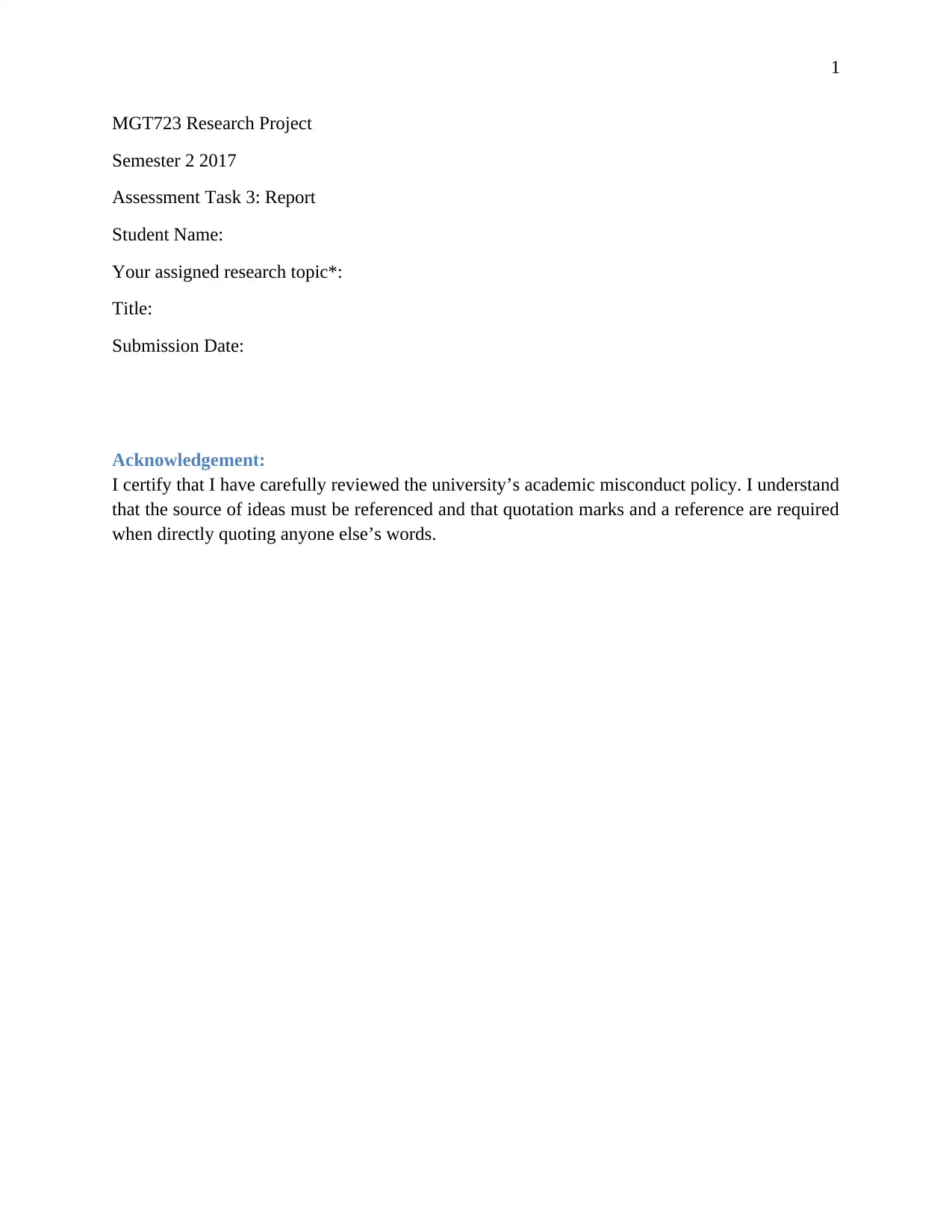
1
MGT723 Research Project
Semester 2 2017
Assessment Task 3: Report
Student Name:
Your assigned research topic*:
Title:
Submission Date:
Acknowledgement:
I certify that I have carefully reviewed the university’s academic misconduct policy. I understand
that the source of ideas must be referenced and that quotation marks and a reference are required
when directly quoting anyone else’s words.
MGT723 Research Project
Semester 2 2017
Assessment Task 3: Report
Student Name:
Your assigned research topic*:
Title:
Submission Date:
Acknowledgement:
I certify that I have carefully reviewed the university’s academic misconduct policy. I understand
that the source of ideas must be referenced and that quotation marks and a reference are required
when directly quoting anyone else’s words.
Paraphrase This Document
Need a fresh take? Get an instant paraphrase of this document with our AI Paraphraser
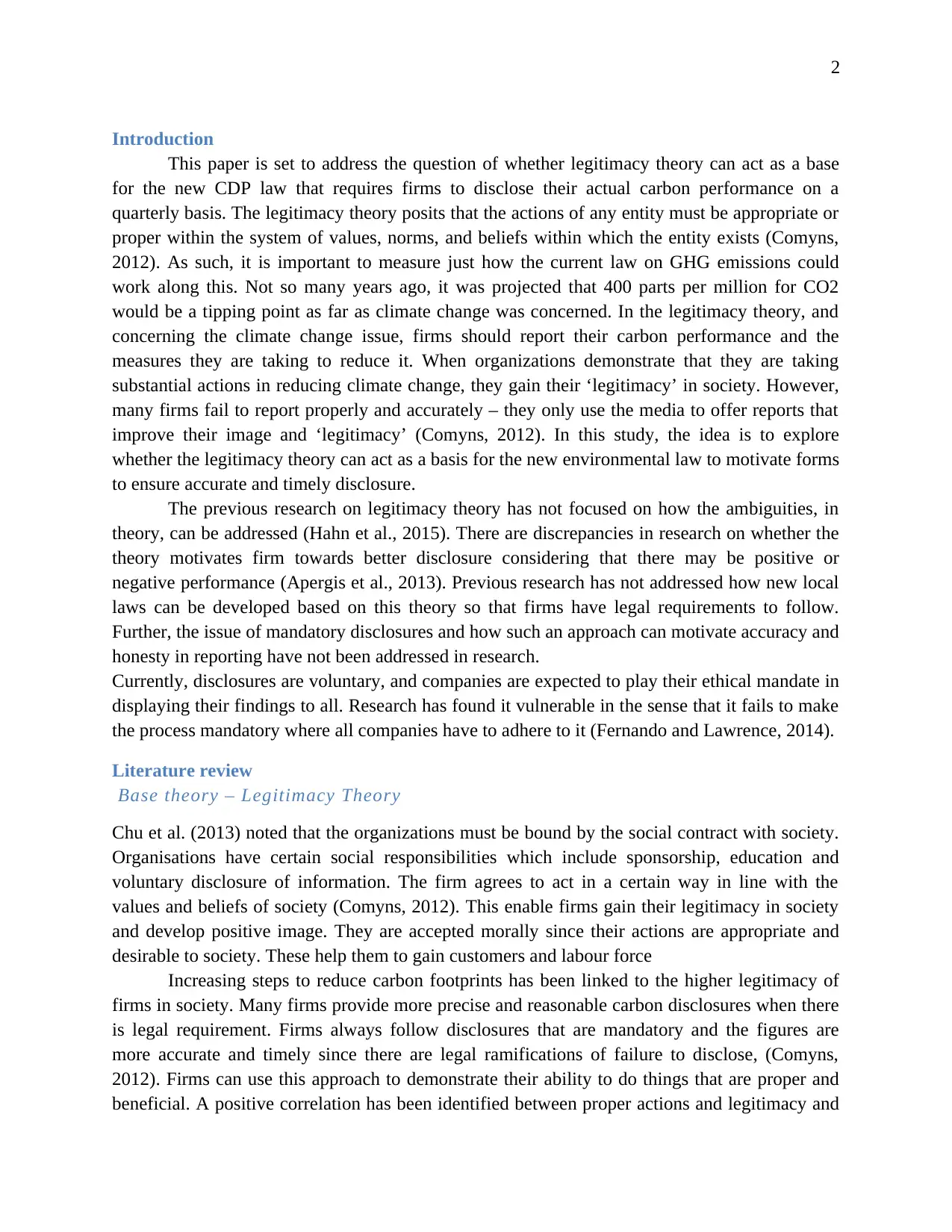
2
Introduction
This paper is set to address the question of whether legitimacy theory can act as a base
for the new CDP law that requires firms to disclose their actual carbon performance on a
quarterly basis. The legitimacy theory posits that the actions of any entity must be appropriate or
proper within the system of values, norms, and beliefs within which the entity exists (Comyns,
2012). As such, it is important to measure just how the current law on GHG emissions could
work along this. Not so many years ago, it was projected that 400 parts per million for CO2
would be a tipping point as far as climate change was concerned. In the legitimacy theory, and
concerning the climate change issue, firms should report their carbon performance and the
measures they are taking to reduce it. When organizations demonstrate that they are taking
substantial actions in reducing climate change, they gain their ‘legitimacy’ in society. However,
many firms fail to report properly and accurately – they only use the media to offer reports that
improve their image and ‘legitimacy’ (Comyns, 2012). In this study, the idea is to explore
whether the legitimacy theory can act as a basis for the new environmental law to motivate forms
to ensure accurate and timely disclosure.
The previous research on legitimacy theory has not focused on how the ambiguities, in
theory, can be addressed (Hahn et al., 2015). There are discrepancies in research on whether the
theory motivates firm towards better disclosure considering that there may be positive or
negative performance (Apergis et al., 2013). Previous research has not addressed how new local
laws can be developed based on this theory so that firms have legal requirements to follow.
Further, the issue of mandatory disclosures and how such an approach can motivate accuracy and
honesty in reporting have not been addressed in research.
Currently, disclosures are voluntary, and companies are expected to play their ethical mandate in
displaying their findings to all. Research has found it vulnerable in the sense that it fails to make
the process mandatory where all companies have to adhere to it (Fernando and Lawrence, 2014).
Literature review
Base theory – Legitimacy Theory
Chu et al. (2013) noted that the organizations must be bound by the social contract with society.
Organisations have certain social responsibilities which include sponsorship, education and
voluntary disclosure of information. The firm agrees to act in a certain way in line with the
values and beliefs of society (Comyns, 2012). This enable firms gain their legitimacy in society
and develop positive image. They are accepted morally since their actions are appropriate and
desirable to society. These help them to gain customers and labour force
Increasing steps to reduce carbon footprints has been linked to the higher legitimacy of
firms in society. Many firms provide more precise and reasonable carbon disclosures when there
is legal requirement. Firms always follow disclosures that are mandatory and the figures are
more accurate and timely since there are legal ramifications of failure to disclose, (Comyns,
2012). Firms can use this approach to demonstrate their ability to do things that are proper and
beneficial. A positive correlation has been identified between proper actions and legitimacy and
Introduction
This paper is set to address the question of whether legitimacy theory can act as a base
for the new CDP law that requires firms to disclose their actual carbon performance on a
quarterly basis. The legitimacy theory posits that the actions of any entity must be appropriate or
proper within the system of values, norms, and beliefs within which the entity exists (Comyns,
2012). As such, it is important to measure just how the current law on GHG emissions could
work along this. Not so many years ago, it was projected that 400 parts per million for CO2
would be a tipping point as far as climate change was concerned. In the legitimacy theory, and
concerning the climate change issue, firms should report their carbon performance and the
measures they are taking to reduce it. When organizations demonstrate that they are taking
substantial actions in reducing climate change, they gain their ‘legitimacy’ in society. However,
many firms fail to report properly and accurately – they only use the media to offer reports that
improve their image and ‘legitimacy’ (Comyns, 2012). In this study, the idea is to explore
whether the legitimacy theory can act as a basis for the new environmental law to motivate forms
to ensure accurate and timely disclosure.
The previous research on legitimacy theory has not focused on how the ambiguities, in
theory, can be addressed (Hahn et al., 2015). There are discrepancies in research on whether the
theory motivates firm towards better disclosure considering that there may be positive or
negative performance (Apergis et al., 2013). Previous research has not addressed how new local
laws can be developed based on this theory so that firms have legal requirements to follow.
Further, the issue of mandatory disclosures and how such an approach can motivate accuracy and
honesty in reporting have not been addressed in research.
Currently, disclosures are voluntary, and companies are expected to play their ethical mandate in
displaying their findings to all. Research has found it vulnerable in the sense that it fails to make
the process mandatory where all companies have to adhere to it (Fernando and Lawrence, 2014).
Literature review
Base theory – Legitimacy Theory
Chu et al. (2013) noted that the organizations must be bound by the social contract with society.
Organisations have certain social responsibilities which include sponsorship, education and
voluntary disclosure of information. The firm agrees to act in a certain way in line with the
values and beliefs of society (Comyns, 2012). This enable firms gain their legitimacy in society
and develop positive image. They are accepted morally since their actions are appropriate and
desirable to society. These help them to gain customers and labour force
Increasing steps to reduce carbon footprints has been linked to the higher legitimacy of
firms in society. Many firms provide more precise and reasonable carbon disclosures when there
is legal requirement. Firms always follow disclosures that are mandatory and the figures are
more accurate and timely since there are legal ramifications of failure to disclose, (Comyns,
2012). Firms can use this approach to demonstrate their ability to do things that are proper and
beneficial. A positive correlation has been identified between proper actions and legitimacy and
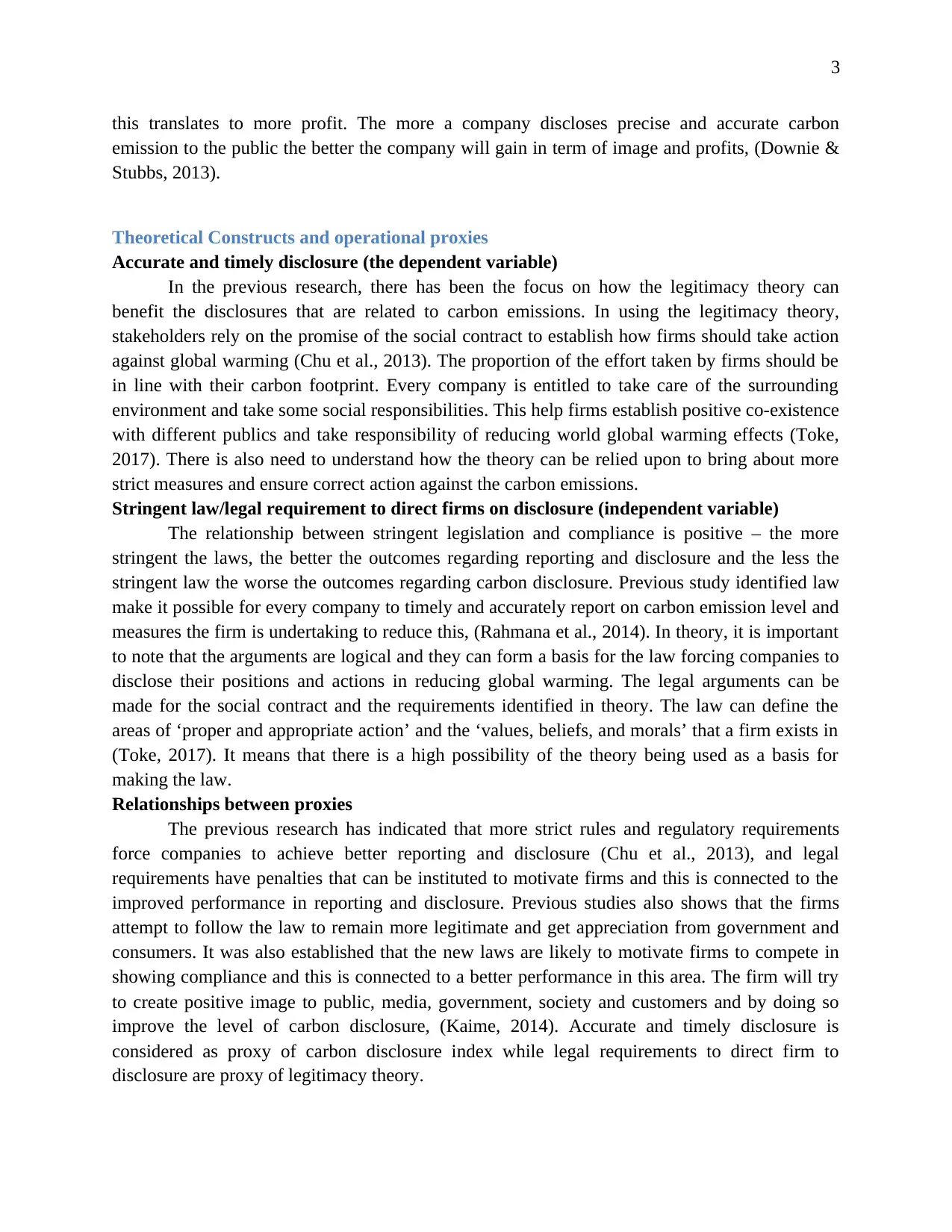
3
this translates to more profit. The more a company discloses precise and accurate carbon
emission to the public the better the company will gain in term of image and profits, (Downie &
Stubbs, 2013).
Theoretical Constructs and operational proxies
Accurate and timely disclosure (the dependent variable)
In the previous research, there has been the focus on how the legitimacy theory can
benefit the disclosures that are related to carbon emissions. In using the legitimacy theory,
stakeholders rely on the promise of the social contract to establish how firms should take action
against global warming (Chu et al., 2013). The proportion of the effort taken by firms should be
in line with their carbon footprint. Every company is entitled to take care of the surrounding
environment and take some social responsibilities. This help firms establish positive co-existence
with different publics and take responsibility of reducing world global warming effects (Toke,
2017). There is also need to understand how the theory can be relied upon to bring about more
strict measures and ensure correct action against the carbon emissions.
Stringent law/legal requirement to direct firms on disclosure (independent variable)
The relationship between stringent legislation and compliance is positive – the more
stringent the laws, the better the outcomes regarding reporting and disclosure and the less the
stringent law the worse the outcomes regarding carbon disclosure. Previous study identified law
make it possible for every company to timely and accurately report on carbon emission level and
measures the firm is undertaking to reduce this, (Rahmana et al., 2014). In theory, it is important
to note that the arguments are logical and they can form a basis for the law forcing companies to
disclose their positions and actions in reducing global warming. The legal arguments can be
made for the social contract and the requirements identified in theory. The law can define the
areas of ‘proper and appropriate action’ and the ‘values, beliefs, and morals’ that a firm exists in
(Toke, 2017). It means that there is a high possibility of the theory being used as a basis for
making the law.
Relationships between proxies
The previous research has indicated that more strict rules and regulatory requirements
force companies to achieve better reporting and disclosure (Chu et al., 2013), and legal
requirements have penalties that can be instituted to motivate firms and this is connected to the
improved performance in reporting and disclosure. Previous studies also shows that the firms
attempt to follow the law to remain more legitimate and get appreciation from government and
consumers. It was also established that the new laws are likely to motivate firms to compete in
showing compliance and this is connected to a better performance in this area. The firm will try
to create positive image to public, media, government, society and customers and by doing so
improve the level of carbon disclosure, (Kaime, 2014). Accurate and timely disclosure is
considered as proxy of carbon disclosure index while legal requirements to direct firm to
disclosure are proxy of legitimacy theory.
this translates to more profit. The more a company discloses precise and accurate carbon
emission to the public the better the company will gain in term of image and profits, (Downie &
Stubbs, 2013).
Theoretical Constructs and operational proxies
Accurate and timely disclosure (the dependent variable)
In the previous research, there has been the focus on how the legitimacy theory can
benefit the disclosures that are related to carbon emissions. In using the legitimacy theory,
stakeholders rely on the promise of the social contract to establish how firms should take action
against global warming (Chu et al., 2013). The proportion of the effort taken by firms should be
in line with their carbon footprint. Every company is entitled to take care of the surrounding
environment and take some social responsibilities. This help firms establish positive co-existence
with different publics and take responsibility of reducing world global warming effects (Toke,
2017). There is also need to understand how the theory can be relied upon to bring about more
strict measures and ensure correct action against the carbon emissions.
Stringent law/legal requirement to direct firms on disclosure (independent variable)
The relationship between stringent legislation and compliance is positive – the more
stringent the laws, the better the outcomes regarding reporting and disclosure and the less the
stringent law the worse the outcomes regarding carbon disclosure. Previous study identified law
make it possible for every company to timely and accurately report on carbon emission level and
measures the firm is undertaking to reduce this, (Rahmana et al., 2014). In theory, it is important
to note that the arguments are logical and they can form a basis for the law forcing companies to
disclose their positions and actions in reducing global warming. The legal arguments can be
made for the social contract and the requirements identified in theory. The law can define the
areas of ‘proper and appropriate action’ and the ‘values, beliefs, and morals’ that a firm exists in
(Toke, 2017). It means that there is a high possibility of the theory being used as a basis for
making the law.
Relationships between proxies
The previous research has indicated that more strict rules and regulatory requirements
force companies to achieve better reporting and disclosure (Chu et al., 2013), and legal
requirements have penalties that can be instituted to motivate firms and this is connected to the
improved performance in reporting and disclosure. Previous studies also shows that the firms
attempt to follow the law to remain more legitimate and get appreciation from government and
consumers. It was also established that the new laws are likely to motivate firms to compete in
showing compliance and this is connected to a better performance in this area. The firm will try
to create positive image to public, media, government, society and customers and by doing so
improve the level of carbon disclosure, (Kaime, 2014). Accurate and timely disclosure is
considered as proxy of carbon disclosure index while legal requirements to direct firm to
disclosure are proxy of legitimacy theory.
⊘ This is a preview!⊘
Do you want full access?
Subscribe today to unlock all pages.

Trusted by 1+ million students worldwide
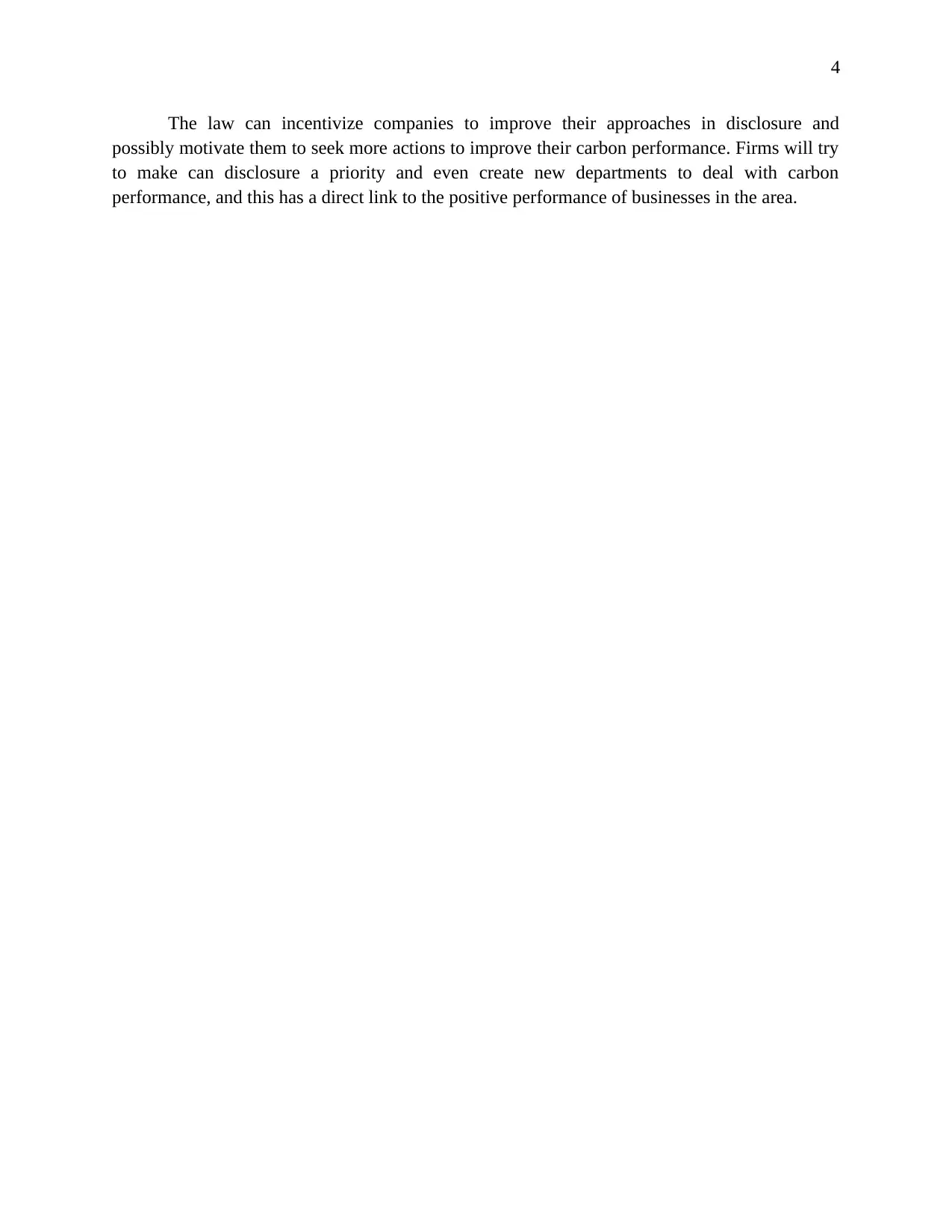
4
The law can incentivize companies to improve their approaches in disclosure and
possibly motivate them to seek more actions to improve their carbon performance. Firms will try
to make can disclosure a priority and even create new departments to deal with carbon
performance, and this has a direct link to the positive performance of businesses in the area.
The law can incentivize companies to improve their approaches in disclosure and
possibly motivate them to seek more actions to improve their carbon performance. Firms will try
to make can disclosure a priority and even create new departments to deal with carbon
performance, and this has a direct link to the positive performance of businesses in the area.
Paraphrase This Document
Need a fresh take? Get an instant paraphrase of this document with our AI Paraphraser
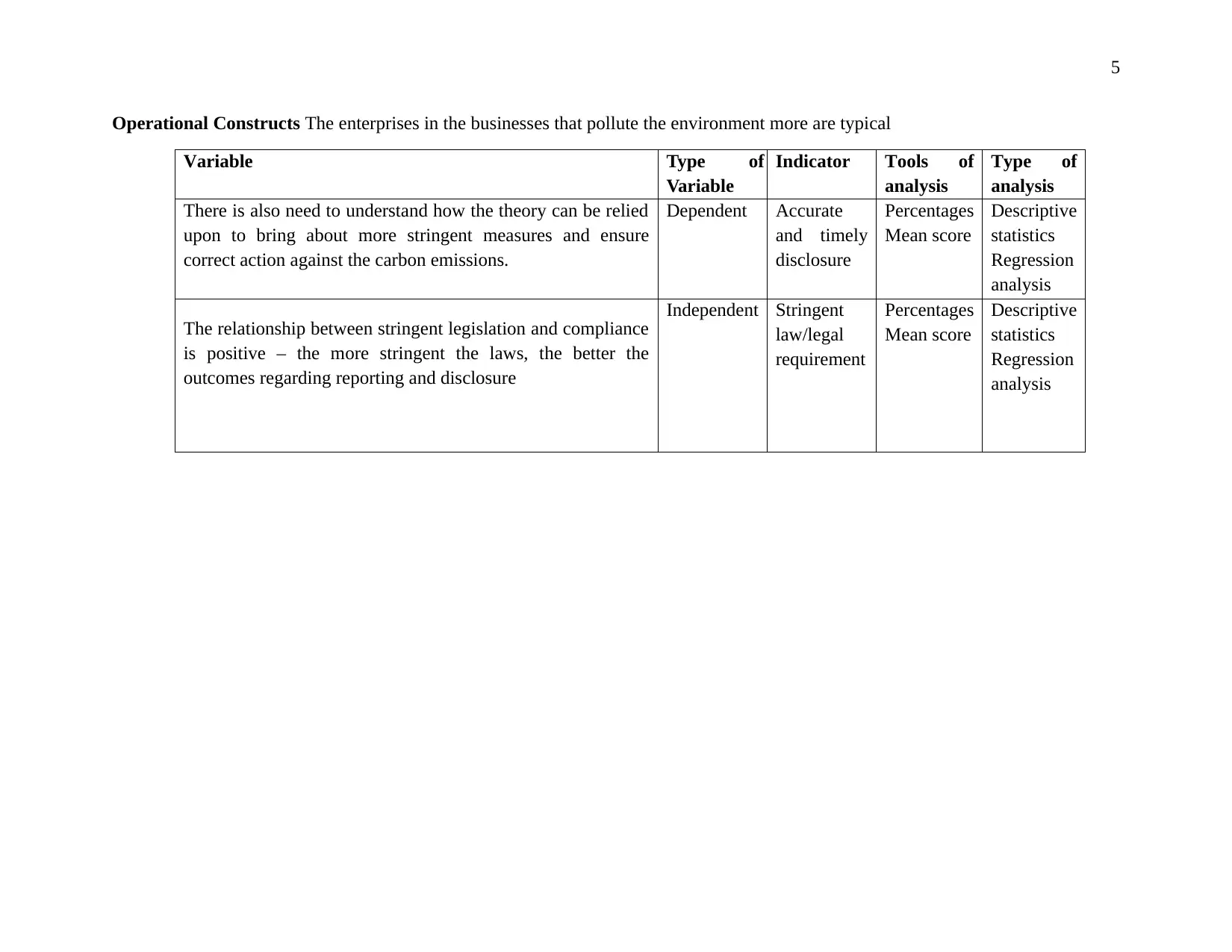
5
Operational Constructs The enterprises in the businesses that pollute the environment more are typical
Variable Type of
Variable
Indicator Tools of
analysis
Type of
analysis
There is also need to understand how the theory can be relied
upon to bring about more stringent measures and ensure
correct action against the carbon emissions.
Dependent Accurate
and timely
disclosure
Percentages
Mean score
Descriptive
statistics
Regression
analysis
The relationship between stringent legislation and compliance
is positive – the more stringent the laws, the better the
outcomes regarding reporting and disclosure
Independent Stringent
law/legal
requirement
Percentages
Mean score
Descriptive
statistics
Regression
analysis
Operational Constructs The enterprises in the businesses that pollute the environment more are typical
Variable Type of
Variable
Indicator Tools of
analysis
Type of
analysis
There is also need to understand how the theory can be relied
upon to bring about more stringent measures and ensure
correct action against the carbon emissions.
Dependent Accurate
and timely
disclosure
Percentages
Mean score
Descriptive
statistics
Regression
analysis
The relationship between stringent legislation and compliance
is positive – the more stringent the laws, the better the
outcomes regarding reporting and disclosure
Independent Stringent
law/legal
requirement
Percentages
Mean score
Descriptive
statistics
Regression
analysis
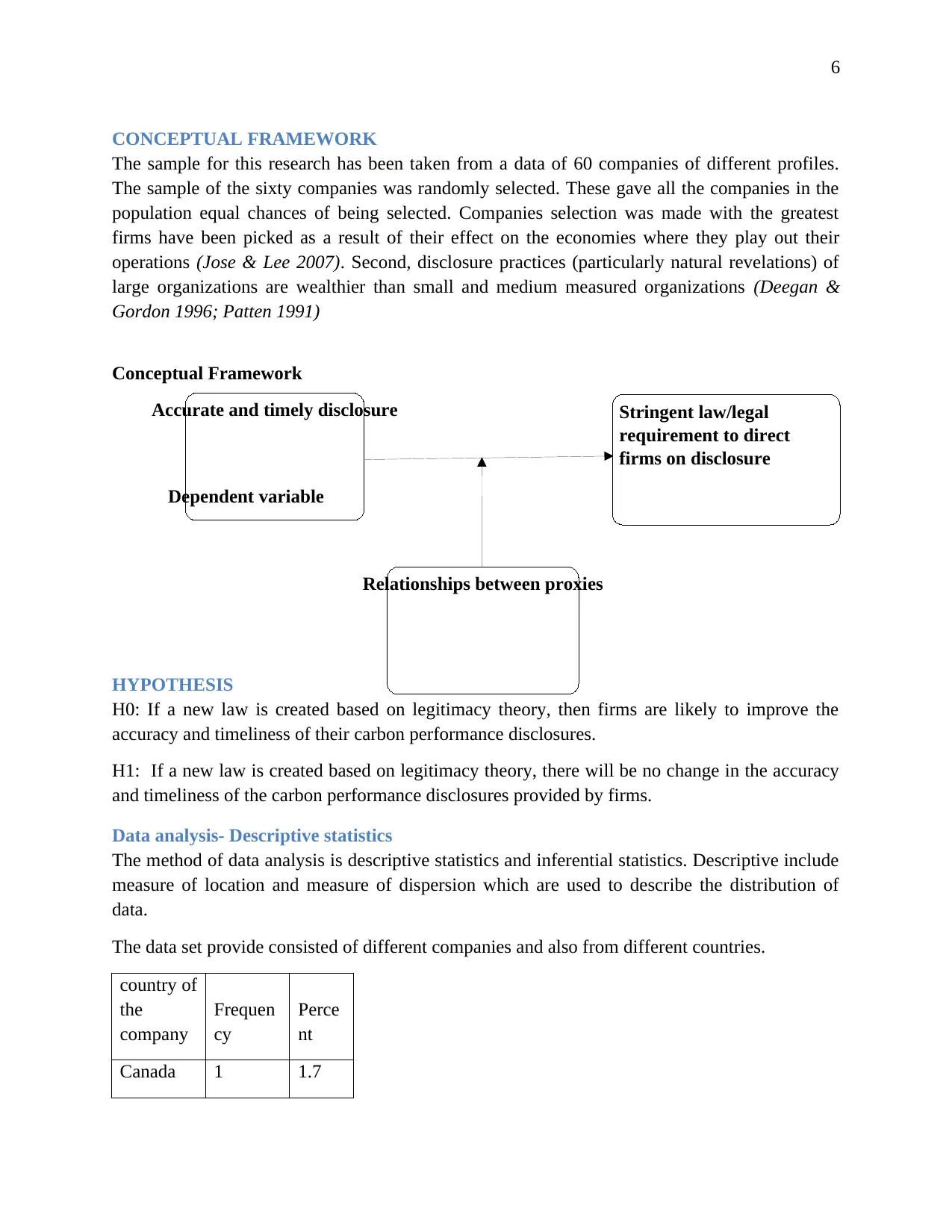
Accurate and timely disclosure
Relationships between proxies
6
CONCEPTUAL FRAMEWORK
The sample for this research has been taken from a data of 60 companies of different profiles.
The sample of the sixty companies was randomly selected. These gave all the companies in the
population equal chances of being selected. Companies selection was made with the greatest
firms have been picked as a result of their effect on the economies where they play out their
operations (Jose & Lee 2007). Second, disclosure practices (particularly natural revelations) of
large organizations are wealthier than small and medium measured organizations (Deegan &
Gordon 1996; Patten 1991)
Conceptual Framework
Dependent variable Independent variable
HYPOTHESIS
H0: If a new law is created based on legitimacy theory, then firms are likely to improve the
accuracy and timeliness of their carbon performance disclosures.
H1: If a new law is created based on legitimacy theory, there will be no change in the accuracy
and timeliness of the carbon performance disclosures provided by firms.
Data analysis- Descriptive statistics
The method of data analysis is descriptive statistics and inferential statistics. Descriptive include
measure of location and measure of dispersion which are used to describe the distribution of
data.
The data set provide consisted of different companies and also from different countries.
country of
the
company
Frequen
cy
Perce
nt
Canada 1 1.7
Stringent law/legal
requirement to direct
firms on disclosure
Relationships between proxies
6
CONCEPTUAL FRAMEWORK
The sample for this research has been taken from a data of 60 companies of different profiles.
The sample of the sixty companies was randomly selected. These gave all the companies in the
population equal chances of being selected. Companies selection was made with the greatest
firms have been picked as a result of their effect on the economies where they play out their
operations (Jose & Lee 2007). Second, disclosure practices (particularly natural revelations) of
large organizations are wealthier than small and medium measured organizations (Deegan &
Gordon 1996; Patten 1991)
Conceptual Framework
Dependent variable Independent variable
HYPOTHESIS
H0: If a new law is created based on legitimacy theory, then firms are likely to improve the
accuracy and timeliness of their carbon performance disclosures.
H1: If a new law is created based on legitimacy theory, there will be no change in the accuracy
and timeliness of the carbon performance disclosures provided by firms.
Data analysis- Descriptive statistics
The method of data analysis is descriptive statistics and inferential statistics. Descriptive include
measure of location and measure of dispersion which are used to describe the distribution of
data.
The data set provide consisted of different companies and also from different countries.
country of
the
company
Frequen
cy
Perce
nt
Canada 1 1.7
Stringent law/legal
requirement to direct
firms on disclosure
⊘ This is a preview!⊘
Do you want full access?
Subscribe today to unlock all pages.

Trusted by 1+ million students worldwide
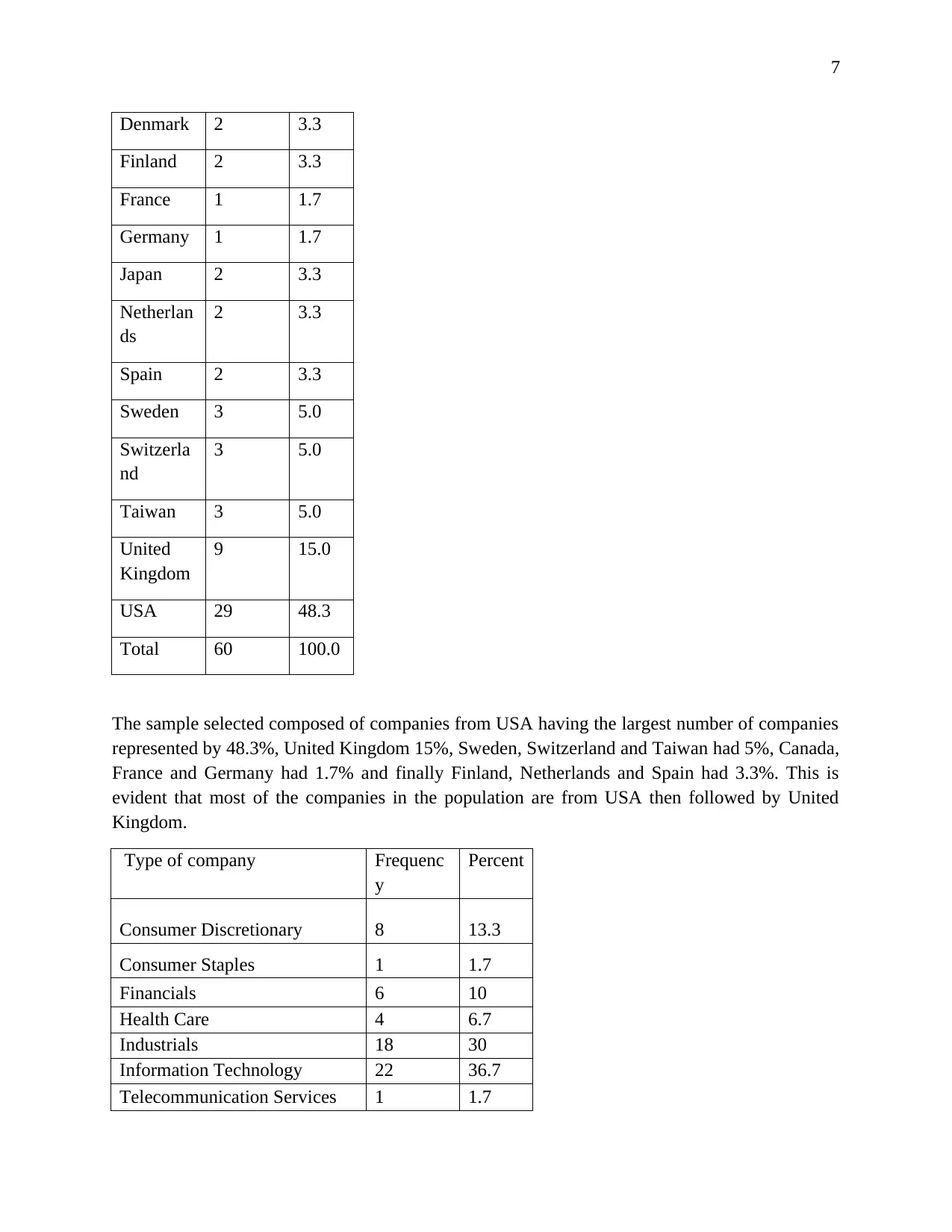
7
Denmark 2 3.3
Finland 2 3.3
France 1 1.7
Germany 1 1.7
Japan 2 3.3
Netherlan
ds
2 3.3
Spain 2 3.3
Sweden 3 5.0
Switzerla
nd
3 5.0
Taiwan 3 5.0
United
Kingdom
9 15.0
USA 29 48.3
Total 60 100.0
The sample selected composed of companies from USA having the largest number of companies
represented by 48.3%, United Kingdom 15%, Sweden, Switzerland and Taiwan had 5%, Canada,
France and Germany had 1.7% and finally Finland, Netherlands and Spain had 3.3%. This is
evident that most of the companies in the population are from USA then followed by United
Kingdom.
Type of company Frequenc
y
Percent
Consumer Discretionary 8 13.3
Consumer Staples 1 1.7
Financials 6 10
Health Care 4 6.7
Industrials 18 30
Information Technology 22 36.7
Telecommunication Services 1 1.7
Denmark 2 3.3
Finland 2 3.3
France 1 1.7
Germany 1 1.7
Japan 2 3.3
Netherlan
ds
2 3.3
Spain 2 3.3
Sweden 3 5.0
Switzerla
nd
3 5.0
Taiwan 3 5.0
United
Kingdom
9 15.0
USA 29 48.3
Total 60 100.0
The sample selected composed of companies from USA having the largest number of companies
represented by 48.3%, United Kingdom 15%, Sweden, Switzerland and Taiwan had 5%, Canada,
France and Germany had 1.7% and finally Finland, Netherlands and Spain had 3.3%. This is
evident that most of the companies in the population are from USA then followed by United
Kingdom.
Type of company Frequenc
y
Percent
Consumer Discretionary 8 13.3
Consumer Staples 1 1.7
Financials 6 10
Health Care 4 6.7
Industrials 18 30
Information Technology 22 36.7
Telecommunication Services 1 1.7
Paraphrase This Document
Need a fresh take? Get an instant paraphrase of this document with our AI Paraphraser
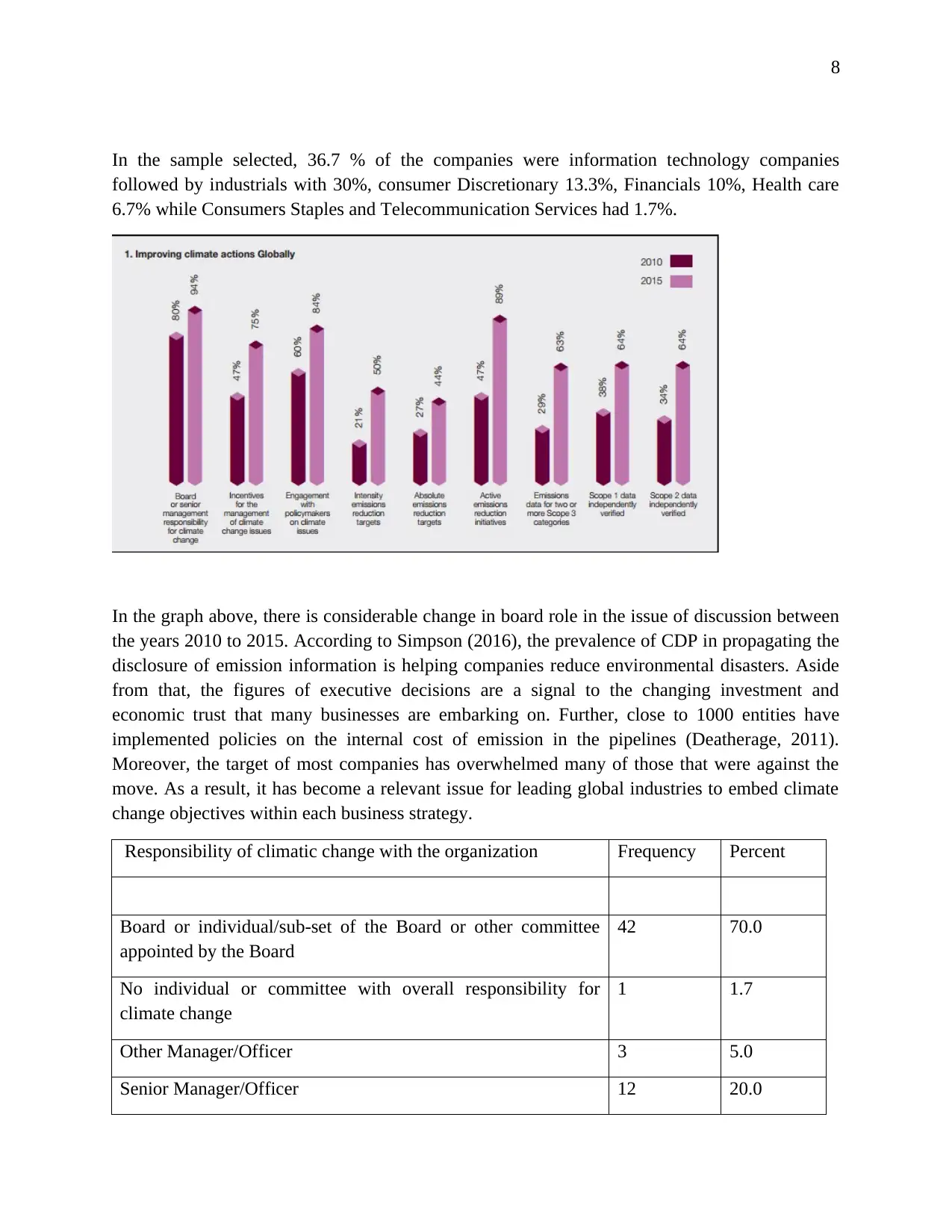
8
In the sample selected, 36.7 % of the companies were information technology companies
followed by industrials with 30%, consumer Discretionary 13.3%, Financials 10%, Health care
6.7% while Consumers Staples and Telecommunication Services had 1.7%.
In the graph above, there is considerable change in board role in the issue of discussion between
the years 2010 to 2015. According to Simpson (2016), the prevalence of CDP in propagating the
disclosure of emission information is helping companies reduce environmental disasters. Aside
from that, the figures of executive decisions are a signal to the changing investment and
economic trust that many businesses are embarking on. Further, close to 1000 entities have
implemented policies on the internal cost of emission in the pipelines (Deatherage, 2011).
Moreover, the target of most companies has overwhelmed many of those that were against the
move. As a result, it has become a relevant issue for leading global industries to embed climate
change objectives within each business strategy.
Responsibility of climatic change with the organization Frequency Percent
Board or individual/sub-set of the Board or other committee
appointed by the Board
42 70.0
No individual or committee with overall responsibility for
climate change
1 1.7
Other Manager/Officer 3 5.0
Senior Manager/Officer 12 20.0
In the sample selected, 36.7 % of the companies were information technology companies
followed by industrials with 30%, consumer Discretionary 13.3%, Financials 10%, Health care
6.7% while Consumers Staples and Telecommunication Services had 1.7%.
In the graph above, there is considerable change in board role in the issue of discussion between
the years 2010 to 2015. According to Simpson (2016), the prevalence of CDP in propagating the
disclosure of emission information is helping companies reduce environmental disasters. Aside
from that, the figures of executive decisions are a signal to the changing investment and
economic trust that many businesses are embarking on. Further, close to 1000 entities have
implemented policies on the internal cost of emission in the pipelines (Deatherage, 2011).
Moreover, the target of most companies has overwhelmed many of those that were against the
move. As a result, it has become a relevant issue for leading global industries to embed climate
change objectives within each business strategy.
Responsibility of climatic change with the organization Frequency Percent
Board or individual/sub-set of the Board or other committee
appointed by the Board
42 70.0
No individual or committee with overall responsibility for
climate change
1 1.7
Other Manager/Officer 3 5.0
Senior Manager/Officer 12 20.0
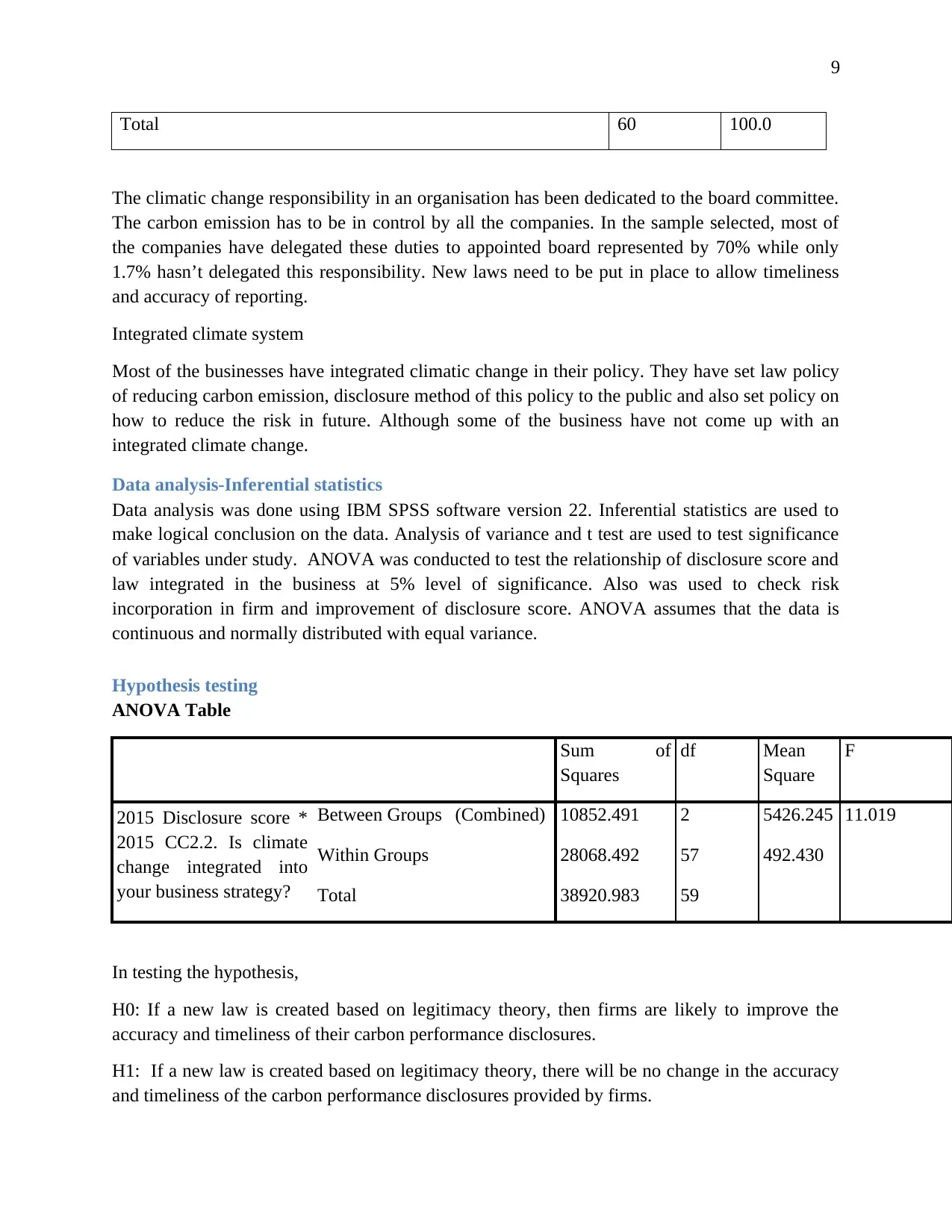
9
Total 60 100.0
The climatic change responsibility in an organisation has been dedicated to the board committee.
The carbon emission has to be in control by all the companies. In the sample selected, most of
the companies have delegated these duties to appointed board represented by 70% while only
1.7% hasn’t delegated this responsibility. New laws need to be put in place to allow timeliness
and accuracy of reporting.
Integrated climate system
Most of the businesses have integrated climatic change in their policy. They have set law policy
of reducing carbon emission, disclosure method of this policy to the public and also set policy on
how to reduce the risk in future. Although some of the business have not come up with an
integrated climate change.
Data analysis-Inferential statistics
Data analysis was done using IBM SPSS software version 22. Inferential statistics are used to
make logical conclusion on the data. Analysis of variance and t test are used to test significance
of variables under study. ANOVA was conducted to test the relationship of disclosure score and
law integrated in the business at 5% level of significance. Also was used to check risk
incorporation in firm and improvement of disclosure score. ANOVA assumes that the data is
continuous and normally distributed with equal variance.
Hypothesis testing
ANOVA Table
Sum of
Squares
df Mean
Square
F
2015 Disclosure score *
2015 CC2.2. Is climate
change integrated into
your business strategy?
Between Groups (Combined) 10852.491 2 5426.245 11.019
Within Groups 28068.492 57 492.430
Total 38920.983 59
In testing the hypothesis,
H0: If a new law is created based on legitimacy theory, then firms are likely to improve the
accuracy and timeliness of their carbon performance disclosures.
H1: If a new law is created based on legitimacy theory, there will be no change in the accuracy
and timeliness of the carbon performance disclosures provided by firms.
Total 60 100.0
The climatic change responsibility in an organisation has been dedicated to the board committee.
The carbon emission has to be in control by all the companies. In the sample selected, most of
the companies have delegated these duties to appointed board represented by 70% while only
1.7% hasn’t delegated this responsibility. New laws need to be put in place to allow timeliness
and accuracy of reporting.
Integrated climate system
Most of the businesses have integrated climatic change in their policy. They have set law policy
of reducing carbon emission, disclosure method of this policy to the public and also set policy on
how to reduce the risk in future. Although some of the business have not come up with an
integrated climate change.
Data analysis-Inferential statistics
Data analysis was done using IBM SPSS software version 22. Inferential statistics are used to
make logical conclusion on the data. Analysis of variance and t test are used to test significance
of variables under study. ANOVA was conducted to test the relationship of disclosure score and
law integrated in the business at 5% level of significance. Also was used to check risk
incorporation in firm and improvement of disclosure score. ANOVA assumes that the data is
continuous and normally distributed with equal variance.
Hypothesis testing
ANOVA Table
Sum of
Squares
df Mean
Square
F
2015 Disclosure score *
2015 CC2.2. Is climate
change integrated into
your business strategy?
Between Groups (Combined) 10852.491 2 5426.245 11.019
Within Groups 28068.492 57 492.430
Total 38920.983 59
In testing the hypothesis,
H0: If a new law is created based on legitimacy theory, then firms are likely to improve the
accuracy and timeliness of their carbon performance disclosures.
H1: If a new law is created based on legitimacy theory, there will be no change in the accuracy
and timeliness of the carbon performance disclosures provided by firms.
⊘ This is a preview!⊘
Do you want full access?
Subscribe today to unlock all pages.

Trusted by 1+ million students worldwide
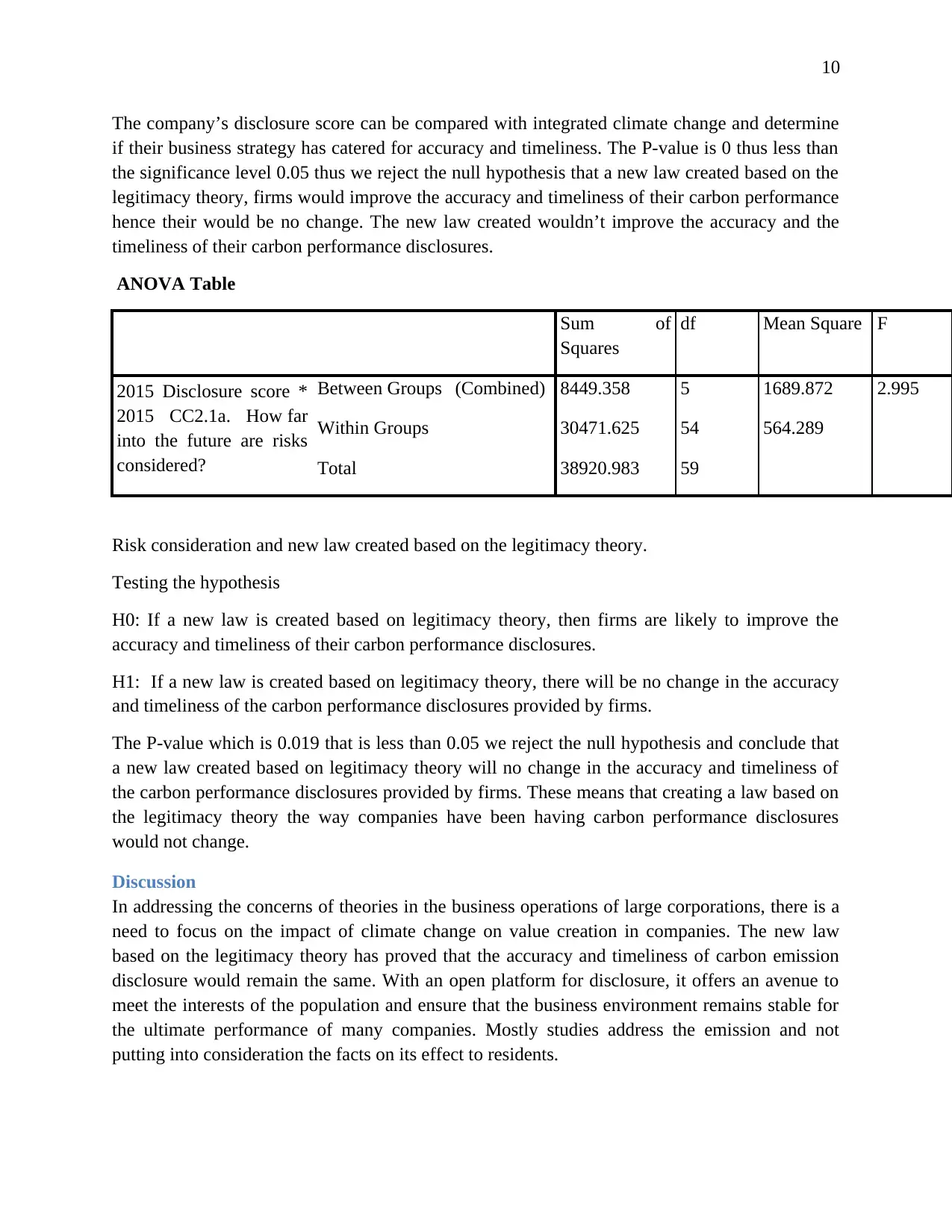
10
The company’s disclosure score can be compared with integrated climate change and determine
if their business strategy has catered for accuracy and timeliness. The P-value is 0 thus less than
the significance level 0.05 thus we reject the null hypothesis that a new law created based on the
legitimacy theory, firms would improve the accuracy and timeliness of their carbon performance
hence their would be no change. The new law created wouldn’t improve the accuracy and the
timeliness of their carbon performance disclosures.
ANOVA Table
Sum of
Squares
df Mean Square F
2015 Disclosure score *
2015 CC2.1a. How far
into the future are risks
considered?
Between Groups (Combined) 8449.358 5 1689.872 2.995
Within Groups 30471.625 54 564.289
Total 38920.983 59
Risk consideration and new law created based on the legitimacy theory.
Testing the hypothesis
H0: If a new law is created based on legitimacy theory, then firms are likely to improve the
accuracy and timeliness of their carbon performance disclosures.
H1: If a new law is created based on legitimacy theory, there will be no change in the accuracy
and timeliness of the carbon performance disclosures provided by firms.
The P-value which is 0.019 that is less than 0.05 we reject the null hypothesis and conclude that
a new law created based on legitimacy theory will no change in the accuracy and timeliness of
the carbon performance disclosures provided by firms. These means that creating a law based on
the legitimacy theory the way companies have been having carbon performance disclosures
would not change.
Discussion
In addressing the concerns of theories in the business operations of large corporations, there is a
need to focus on the impact of climate change on value creation in companies. The new law
based on the legitimacy theory has proved that the accuracy and timeliness of carbon emission
disclosure would remain the same. With an open platform for disclosure, it offers an avenue to
meet the interests of the population and ensure that the business environment remains stable for
the ultimate performance of many companies. Mostly studies address the emission and not
putting into consideration the facts on its effect to residents.
The company’s disclosure score can be compared with integrated climate change and determine
if their business strategy has catered for accuracy and timeliness. The P-value is 0 thus less than
the significance level 0.05 thus we reject the null hypothesis that a new law created based on the
legitimacy theory, firms would improve the accuracy and timeliness of their carbon performance
hence their would be no change. The new law created wouldn’t improve the accuracy and the
timeliness of their carbon performance disclosures.
ANOVA Table
Sum of
Squares
df Mean Square F
2015 Disclosure score *
2015 CC2.1a. How far
into the future are risks
considered?
Between Groups (Combined) 8449.358 5 1689.872 2.995
Within Groups 30471.625 54 564.289
Total 38920.983 59
Risk consideration and new law created based on the legitimacy theory.
Testing the hypothesis
H0: If a new law is created based on legitimacy theory, then firms are likely to improve the
accuracy and timeliness of their carbon performance disclosures.
H1: If a new law is created based on legitimacy theory, there will be no change in the accuracy
and timeliness of the carbon performance disclosures provided by firms.
The P-value which is 0.019 that is less than 0.05 we reject the null hypothesis and conclude that
a new law created based on legitimacy theory will no change in the accuracy and timeliness of
the carbon performance disclosures provided by firms. These means that creating a law based on
the legitimacy theory the way companies have been having carbon performance disclosures
would not change.
Discussion
In addressing the concerns of theories in the business operations of large corporations, there is a
need to focus on the impact of climate change on value creation in companies. The new law
based on the legitimacy theory has proved that the accuracy and timeliness of carbon emission
disclosure would remain the same. With an open platform for disclosure, it offers an avenue to
meet the interests of the population and ensure that the business environment remains stable for
the ultimate performance of many companies. Mostly studies address the emission and not
putting into consideration the facts on its effect to residents.
Paraphrase This Document
Need a fresh take? Get an instant paraphrase of this document with our AI Paraphraser
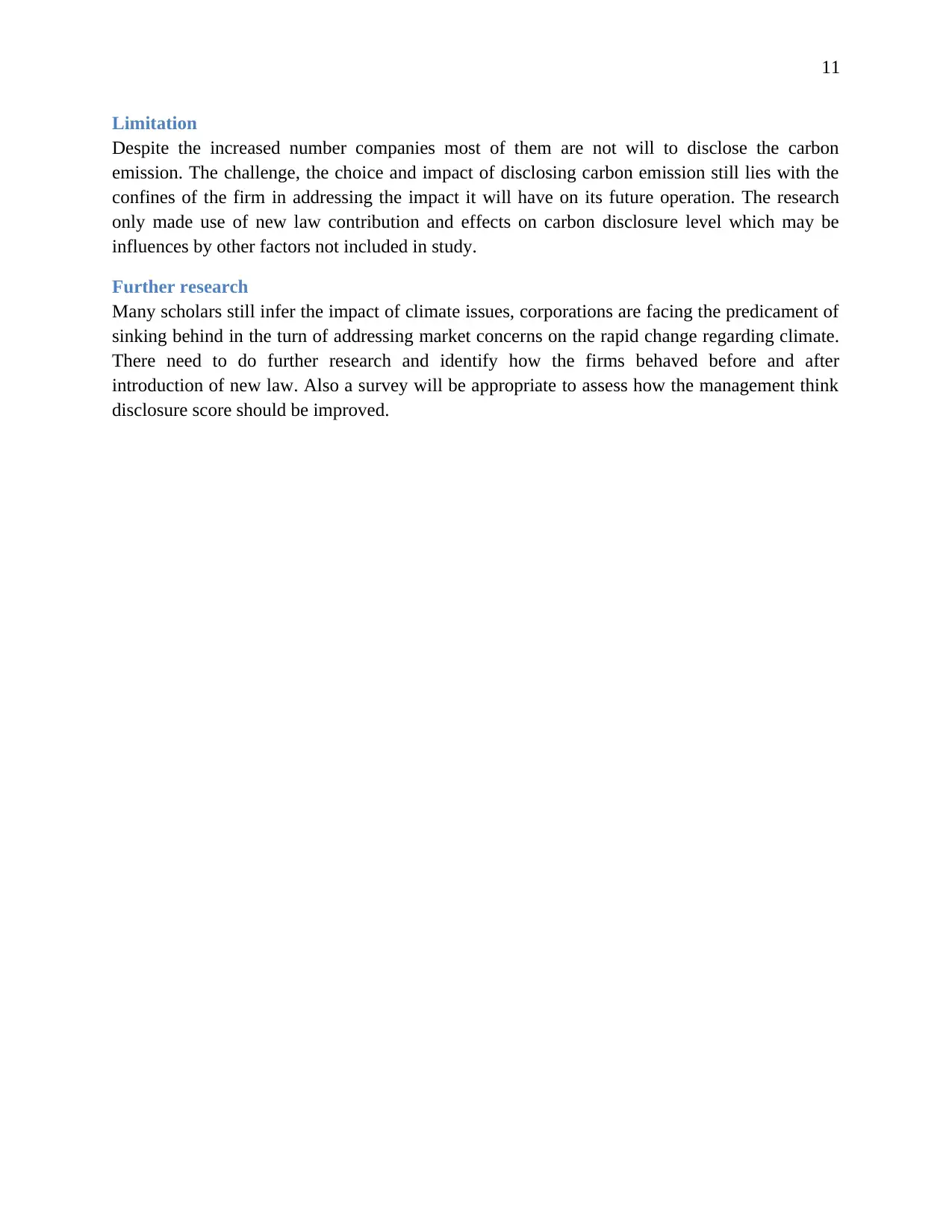
11
Limitation
Despite the increased number companies most of them are not will to disclose the carbon
emission. The challenge, the choice and impact of disclosing carbon emission still lies with the
confines of the firm in addressing the impact it will have on its future operation. The research
only made use of new law contribution and effects on carbon disclosure level which may be
influences by other factors not included in study.
Further research
Many scholars still infer the impact of climate issues, corporations are facing the predicament of
sinking behind in the turn of addressing market concerns on the rapid change regarding climate.
There need to do further research and identify how the firms behaved before and after
introduction of new law. Also a survey will be appropriate to assess how the management think
disclosure score should be improved.
Limitation
Despite the increased number companies most of them are not will to disclose the carbon
emission. The challenge, the choice and impact of disclosing carbon emission still lies with the
confines of the firm in addressing the impact it will have on its future operation. The research
only made use of new law contribution and effects on carbon disclosure level which may be
influences by other factors not included in study.
Further research
Many scholars still infer the impact of climate issues, corporations are facing the predicament of
sinking behind in the turn of addressing market concerns on the rapid change regarding climate.
There need to do further research and identify how the firms behaved before and after
introduction of new law. Also a survey will be appropriate to assess how the management think
disclosure score should be improved.
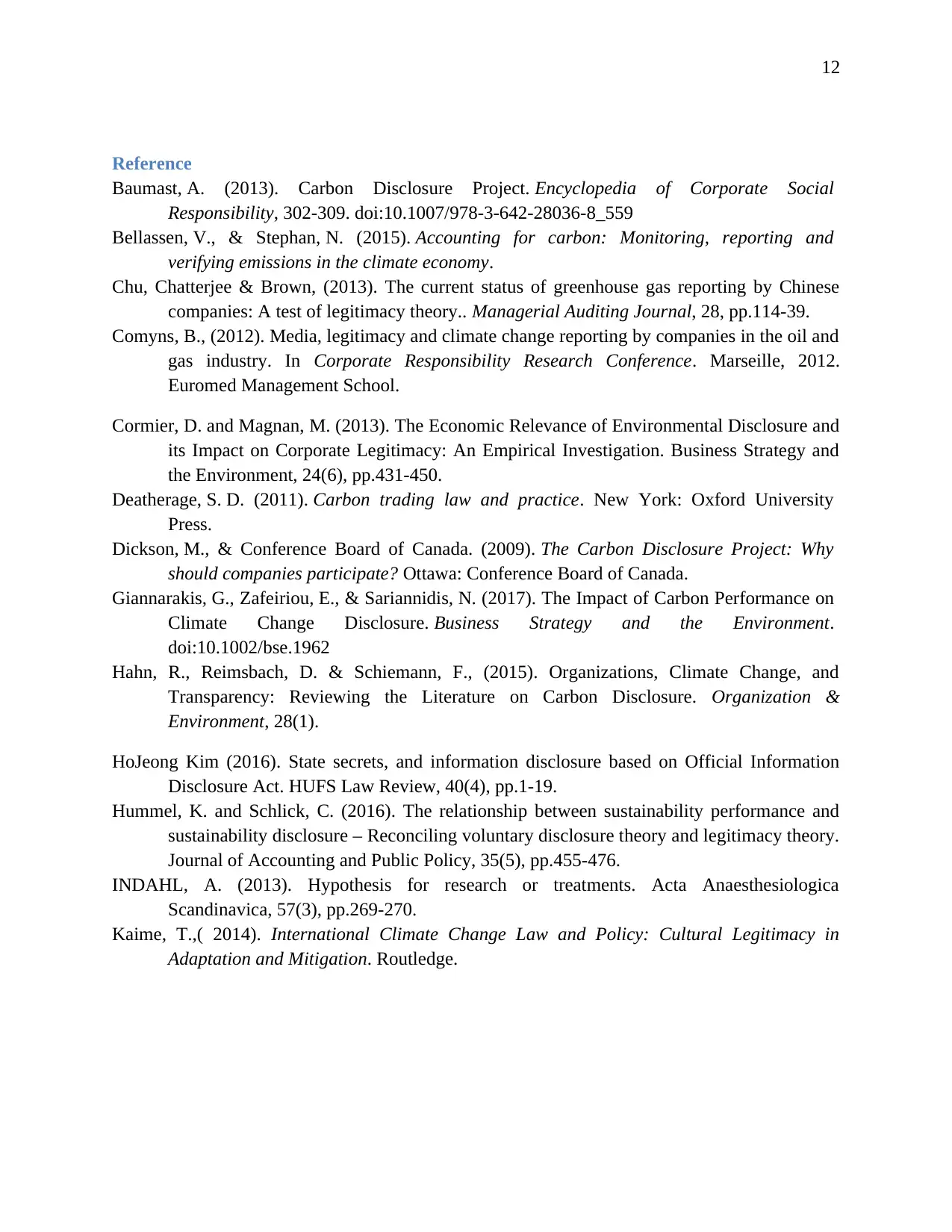
12
Reference
Baumast, A. (2013). Carbon Disclosure Project. Encyclopedia of Corporate Social
Responsibility, 302-309. doi:10.1007/978-3-642-28036-8_559
Bellassen, V., & Stephan, N. (2015). Accounting for carbon: Monitoring, reporting and
verifying emissions in the climate economy.
Chu, Chatterjee & Brown, (2013). The current status of greenhouse gas reporting by Chinese
companies: A test of legitimacy theory.. Managerial Auditing Journal, 28, pp.114-39.
Comyns, B., (2012). Media, legitimacy and climate change reporting by companies in the oil and
gas industry. In Corporate Responsibility Research Conference. Marseille, 2012.
Euromed Management School.
Cormier, D. and Magnan, M. (2013). The Economic Relevance of Environmental Disclosure and
its Impact on Corporate Legitimacy: An Empirical Investigation. Business Strategy and
the Environment, 24(6), pp.431-450.
Deatherage, S. D. (2011). Carbon trading law and practice. New York: Oxford University
Press.
Dickson, M., & Conference Board of Canada. (2009). The Carbon Disclosure Project: Why
should companies participate? Ottawa: Conference Board of Canada.
Giannarakis, G., Zafeiriou, E., & Sariannidis, N. (2017). The Impact of Carbon Performance on
Climate Change Disclosure. Business Strategy and the Environment.
doi:10.1002/bse.1962
Hahn, R., Reimsbach, D. & Schiemann, F., (2015). Organizations, Climate Change, and
Transparency: Reviewing the Literature on Carbon Disclosure. Organization &
Environment, 28(1).
HoJeong Kim (2016). State secrets, and information disclosure based on Official Information
Disclosure Act. HUFS Law Review, 40(4), pp.1-19.
Hummel, K. and Schlick, C. (2016). The relationship between sustainability performance and
sustainability disclosure – Reconciling voluntary disclosure theory and legitimacy theory.
Journal of Accounting and Public Policy, 35(5), pp.455-476.
INDAHL, A. (2013). Hypothesis for research or treatments. Acta Anaesthesiologica
Scandinavica, 57(3), pp.269-270.
Kaime, T.,( 2014). International Climate Change Law and Policy: Cultural Legitimacy in
Adaptation and Mitigation. Routledge.
Reference
Baumast, A. (2013). Carbon Disclosure Project. Encyclopedia of Corporate Social
Responsibility, 302-309. doi:10.1007/978-3-642-28036-8_559
Bellassen, V., & Stephan, N. (2015). Accounting for carbon: Monitoring, reporting and
verifying emissions in the climate economy.
Chu, Chatterjee & Brown, (2013). The current status of greenhouse gas reporting by Chinese
companies: A test of legitimacy theory.. Managerial Auditing Journal, 28, pp.114-39.
Comyns, B., (2012). Media, legitimacy and climate change reporting by companies in the oil and
gas industry. In Corporate Responsibility Research Conference. Marseille, 2012.
Euromed Management School.
Cormier, D. and Magnan, M. (2013). The Economic Relevance of Environmental Disclosure and
its Impact on Corporate Legitimacy: An Empirical Investigation. Business Strategy and
the Environment, 24(6), pp.431-450.
Deatherage, S. D. (2011). Carbon trading law and practice. New York: Oxford University
Press.
Dickson, M., & Conference Board of Canada. (2009). The Carbon Disclosure Project: Why
should companies participate? Ottawa: Conference Board of Canada.
Giannarakis, G., Zafeiriou, E., & Sariannidis, N. (2017). The Impact of Carbon Performance on
Climate Change Disclosure. Business Strategy and the Environment.
doi:10.1002/bse.1962
Hahn, R., Reimsbach, D. & Schiemann, F., (2015). Organizations, Climate Change, and
Transparency: Reviewing the Literature on Carbon Disclosure. Organization &
Environment, 28(1).
HoJeong Kim (2016). State secrets, and information disclosure based on Official Information
Disclosure Act. HUFS Law Review, 40(4), pp.1-19.
Hummel, K. and Schlick, C. (2016). The relationship between sustainability performance and
sustainability disclosure – Reconciling voluntary disclosure theory and legitimacy theory.
Journal of Accounting and Public Policy, 35(5), pp.455-476.
INDAHL, A. (2013). Hypothesis for research or treatments. Acta Anaesthesiologica
Scandinavica, 57(3), pp.269-270.
Kaime, T.,( 2014). International Climate Change Law and Policy: Cultural Legitimacy in
Adaptation and Mitigation. Routledge.
⊘ This is a preview!⊘
Do you want full access?
Subscribe today to unlock all pages.

Trusted by 1+ million students worldwide
1 out of 12
Related Documents
Your All-in-One AI-Powered Toolkit for Academic Success.
+13062052269
info@desklib.com
Available 24*7 on WhatsApp / Email
![[object Object]](/_next/static/media/star-bottom.7253800d.svg)
Unlock your academic potential
Copyright © 2020–2025 A2Z Services. All Rights Reserved. Developed and managed by ZUCOL.





